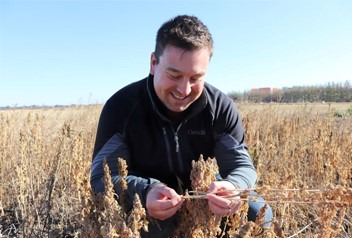Over the past 10 years, interest in quinoa has increased. This popular seed is a complete protein, packed with vitamins and high in fibre. There’s an opportunity for Canadian producers here, as quinoa can grow in diverse environments and consumer demand seems to be growing. How has the Canadian agriculture industry responded to this demand?
According to Marc Vincent, Director of Research and Development at NorQuin (Northern Quinoa Production Corporation), it’s all about research.
“Quinoa has the potential to be a very profitable crop as it has tolerance to drought, frost and saline soils,” says Vincent. “It can be grown in marginal soil types but excels well in the fertile soils of Western Canada.”
Agriculture and Agri-Food Canada (AAFC) is helping the development of quinoa in many ways, including direct research as well as providing funding through the Diverse Field Crops Cluster. The cluster aims to support the research and development of high-potential, special crops such as flax, camelina, canaryseed, sunflower, hemp, quinoa and mustard. From pest management to new varietal development to developing best management practices, research is ramping up so that farmers can really take advantage of this new crop.
For NorQuin, the goal is to improve agronomic practices and varietal development for western Canada—to create varieties that are higher yielding, earlier maturing (100-120 days), free of saponin (an unpalatable seed coating), higher protein and meet quality requirements of industry and consumers.
The agronomic aspects of the crop are also very important. AAFC researchers Dr. Rob Nurse, Dr. Eric Page and Kerry Bosveld at the Harrow Research and Development Centre in Ontario are looking at ways to expand production of quinoa as well as a related plant called amaranth through southwestern Ontario, by studying the best ways to grow quinoa and amaranth in a typical crop rotation using organic production principles.
Because quinoa is a relatively new crop in Canada, all the factors associated with growing it—from moisture needs to crop pests—need to be researched.
According to Dr. Tyler Wist, Research Scientist and Field Crops Entomologist in Saskatchewan, quinoa is a popular food for insects. “We’ve identified four insects with the potential to completely wipe out a quinoa crop in Western Canada, plus another 11 insects that will feed in quinoa. We’re collecting enough data to understand their lifecycles in crops,” he says.
The eventual goal will be to make recommendations to farmers about pest management techniques.
Thanks to research being funded in part by, led by and in collaboration with AAFC and NorQuin, farmers are seeing new opportunities from this ancient seed.


Top: Dr. Tyler Wist inspects the stem of a quinoa plant.
Middle: The stem of this quinoa plant show extensive insect damage.
Bottom: A handful of quinoa ready for cooking.
